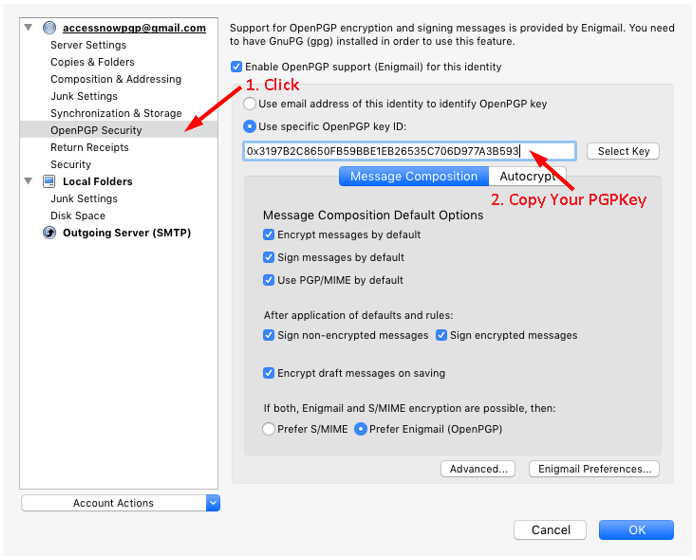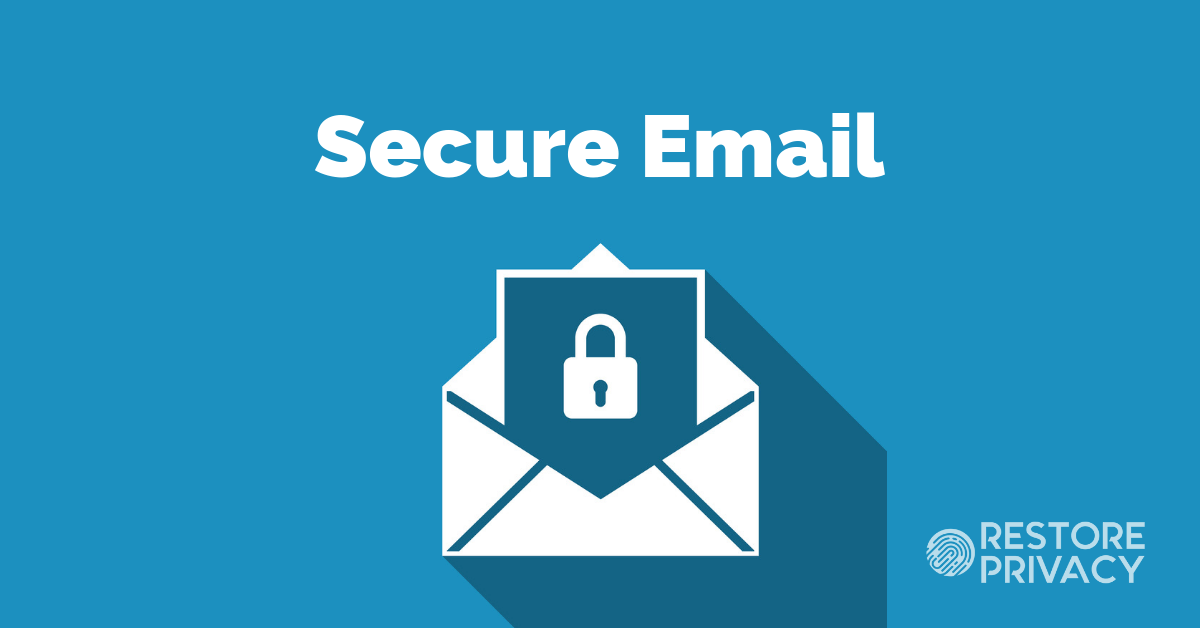You can get pgp encryption for iOS by using the EasyPGP app. It integrates with the iOS keyboard so you can have pgp everywhere, with any email client with just 2 clicks. IPad and iPhone compatible 0. May 14, 2018 This short how-to guides users through the steps necessary to remove the popular open-source encryption plugin GPG Tools (GPGMail) ('from Apple Mail. Jul 26, 2012 To disable email encryption, Open Outlook Tools Trust Center E-mail Security Encrypted e-mail uncheck Encrypt contents and attachments for outgoing messages check box click OK. Now try to send emails and check if it helps. 29 people were helped by this reply. Apr 17, 2020 All email applications on this page support the OpenPGP standard either directly or with additional software. The authors of this webpage are not actively participating in the development of each of these third-party apps. Email Encryption Actually Begins With Apple Mail The built-in email client that comes with macOS Sierra actually has encryption capability built into it. Even better, it actually works really well. Mar 29, 2019 Tap the back button to return to the Advanced menu. This tells the Mail app to encrypt the message you are about to send. If the lock was already locked, don’t tap it—this will just disable encryption.

If you use the Mail app on your Mac for work, or just want more security in your messages, then you will want to look at encrypting them. But how do you do this in Mail for Mac? It's a little complex, but we'll show you how to do so in this guide.
How do I obtain a personal certificate?
Before you are able to start sending and receiving encrypted emails, you will need to have a personal certificate in your Keychain. To get one, do the following:
Launch Keychain Access on your Mac (Macintosh HD > Applications > Utilities > Keychain Access).
- Click Keychain Access in the menubar.
Hover over Certificate Assistant and click Request a Certificate From a Certificate Authority.
- Fill out the request form with your own information.
- For CA Email Address, you should check services like VeriSign, Inc. or RSA Data Security Inc. These are companies that verify the identities of computers on a network and issues certificates.
- Choose whether or not you want the certificate emailed to the CA or Saved to Disk.
Click Continue.
- If you chose Saved to Disk, specify the location to save to.
Locate the certificates and open them with Certificate Assistant.
- Select the Issuing CA from the drop-down menu.
- You can choose to override the defaults if need be.
Click Continue.
- Select the Create a certificate for yourself option.
Click Continue.
Double check the information, and then click Create.
- You should select Self Signed Root as the default.
- Certificate type should be S/MIME (Email).
- It will prompt you for confirmation. Click Continue.
Your certificate has been created, so click Done.
Once you create your certificate, it is automatically added to Keychain.
How do I send digitally signed and encrypted emails on Mail for Mac
When you have your certificate, it means that your recipients can verify you as the sender, adding another layer of security. However, to send encrypted messages, the recipient's certificate must be in your keychain.

- Launch Mail on your Mac.
Click on the Compose button, or File > New Message to create a new message.
- In the From field, click and choose the email account that you have a personal certificate for in your keychain.
In the subject line, there will be a checkmark box at the end on the account with a certificate. Click the checkmark button to turn on your digital signature.
- Address the email message to your recipients.
- The Encrypted symbol (closed lock) will appear next to the Signed icon if you have a certificate for every single recipient that the message is being addressed to.
- If you do not have the certificate for all recipients, then the message must be sent unencrypted.
How to receive digitally signed and encrypted emails on Mail for Mac
Again, remember that you need to provide senders with your own verified certificate in order to receive encrypted messages.
Mail for Mac has a Security field in the header area that indicates whether a message is signed or encrypted.
For signed messages, you will see a signed icon (checkmark) in the header. If you need to, just click the icon to view certificate details.
- Messages that are altered after they've been signed will have issues with verification.
- For encrypted messages, a lock icon appears in the header. If you have your private key in Keychain, the message will be decrypted for viewing. Otherwise, it won't be decrypted.
Always have these necessities on-hand
Seagate Backup Plus Slim 1TB($50 at Amazon)
You should always be backing up your computer. This Seagate portable drive goes up to 5TB in space and will work flawlessly with your Mac. It's highly affordable, so there's no reason why you shouldn't be backing up regularly. Keep your certificate copies on this secure drive!
Gesture-based email($99 at Amazon)
The Magic Trackpad lets you swipe and tap away with ease! This will help make managing your email easier due to easily accessible gestures.
Apple Magic Keyboard with Numeric Keypad($139 at Amazon)
If you're going to be dealing with email all day, then make sure you have the Magic Keyboard with Numeric Keypad. It comes in the awesome space gray color, and the number pad makes it easier to type in numbers when you need them.
Questions?
Having digital signatures and encryption on email may seem like a lot of extra work, but if you want security and peace of mind when it comes to important email messages, then it's the best way. After all, who wants just anyone to see their top secret plans and whatnot?
Any questions, drop them in the comments and we'll do our best to help.

We may earn a commission for purchases using our links. Learn more.
educationApple announces new initiative with HBCUs to boost coding and creativity
Apple has today announced expanded partnerships with Historically Black Colleges and Universities to boost coding and creativity opportunities.
Researchers have found flaws in the HTML rendering of Apple Mail on Mac and iOS, as well as Mozilla Thunderbird, that allows attackers to extract decrypted plain text from encrypted mail messages.
Pgp Email Encryption Outlook
Whilst most email is sent unencrypted, many businesses and people rely on S/MIME and PGP encrypted email communications to talk in private. These newly published security holes undermine the security of supposedly private email conversations.
The primary issue affecting Apple Mail, iOS Mail and Mozilla’s Thunderbird client, is a method that uses multipart responses to exploit HTML rendering issues.
If an attacker obtains encrypted email content from a person, it is possible to send that encrypted text back to the user and reveal the decrypted plaintext form without ever having access to the sender’s private encryption keys.
Essentially, an attacker sends three parts — a partial HTML <img> tag declaration, a string of encrypted text, followed by the closing HTML for the image tag. This results in the Mail client decrypting the ciphertext, and rendering it as the fake image’s source URL.
When the person opens the email on their local client, it will attempt to fetch the URL to load the image. The attacker’s server logs the request and now has a copy of the decrypted content. Obviously, the URL’s domain is controlled by the attacker to achieve this; ‘efail.de’ in this example.
This flaw in Apple’s Mac Mail app, and Mail for iPhone and iPad, can be resolved with a software update which is no doubt already in the works. The GPG plugin for macOS will be releasing an update to mitigate against these attacks soon. It’s important to note that this exploit is only useful if an unscrupulous individual already has access to the encrypted S/MIME or PGP emails.
The attack relies on contacting the same person that sent the encrypted email in the first place. It’s not possible to email someone out of the blue and have a server receive a stream of decrypted content. The potential for compromised communications increases if the email is part of a group conversation, as the attacker only needs to target one person in the chain to pull off the decryption.
If you are worried about being targeted by this, you can disable the loading of remote content as a mitigation before Apple officially updates its apps to close the loophole. For Apple Mail on Mac, this is a toggle labelled ‘Load remote content in messages’ in Mail Preferences. On iOS, this setting is called ‘Load Remote Images’, found in iOS Settings. As a more extreme measure, you could remove the PGP keys from the mail client entirely, preventing the app from any decrypting encoded strings.
In addition to the HTML rendering issue, the EFAIL researchers also posted a more technical exploit of the S/MIME standard specification itself which affects twenty-something clients in addition to Apple’s. This is a much more technical flaw; you can read about it in detail on the EFAIL website. Long term, comprehensively patching this particular vulnerability will require an update to the underlying email encryption standards.
Online Pgp Encrypt
FTC: We use income earning auto affiliate links.More.